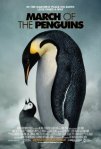This post had been sitting in my draft folder since 2009. I’m finally posting this 6 years later 🙂
 During my recent hibernation, as I was browsing through my cable movie channels ,I happened to catch the latter half of the movie The March of the Penguins. This award winning documentary film chronicles the poignant saga of the penguin’s quest of fulfilling nature’s sacred and unwritten rule – the preservation and propagation of the specie. Every specie on this earth is innately programmed to propagate its own. The rites and rituals can vary in many ways, sometimes strange and inexplicable, much like the landlocked North American salmon that die once it has spawned. But we humans are touched when we see animals such as the lowly and sluggish penguin exhibit strikingly similar social and emotional characteristics as us.
During my recent hibernation, as I was browsing through my cable movie channels ,I happened to catch the latter half of the movie The March of the Penguins. This award winning documentary film chronicles the poignant saga of the penguin’s quest of fulfilling nature’s sacred and unwritten rule – the preservation and propagation of the specie. Every specie on this earth is innately programmed to propagate its own. The rites and rituals can vary in many ways, sometimes strange and inexplicable, much like the landlocked North American salmon that die once it has spawned. But we humans are touched when we see animals such as the lowly and sluggish penguin exhibit strikingly similar social and emotional characteristics as us.
The penguin mating scenario is highly unusual. In the midst of the extremely cold and icy environment penguins trek to the high ground and choose their partner for the mating season. It may look shockingly promiscuous to us humans but the relationship albeit temporary is a monogamous one where both partners exhibit genuine dedication to the mission of propagation, the caring and nurturing of their offspring. Father and mother penguin take turns to feed itself and bring food for the young while one of them does the baby sitting. It may take days or even weeks for the partner to return from the hunt. In one scene in the film, a baby penguin dies of cold after a harsh winter storm when the mother wasn’t able to provide enough body heat from her bosom. Distraught at the loss of her young, the grieving mother tries to snatch a fellow mother’s baby whereupon the rest of the penguins intervene and quell her indiscretion in her moment of insanity. It is amazing how such display of love and affection can touch the human heart. The reproduction ritual happens annually in the grueling sub-zero temperatures between fall and spring. The weather, lack of food and ample shelter are the rude challenges to the penguin’s tenacity and unflagging energy.
One might be all praise and awe at the penguin’s character but there is an astonishing twist which happens the tail end of the breeding cycle (14-16 months). At this stage, their offspring are now bigger, still sporting some fur in their bodies but clearly hale and able to ambulate on their own. As soon as the ice breaks exposing the sea and the sun starts to light up the gloomy skies of the frozen land, the mother penguin who at this stage takes responsibility of feeding the offspring begins to manifest a bizarre character. As the chick grows bigger and incessantly harass mother penguin for food, the latter becomes severely overworked with the non stop demand and the stress triggers a defense mechanism , that of self-preservation. The adult penguins begin to rush to frolic into the open sea feasting on fish, swim across to the other side of the water, unmindful and oblivious of their offspring. It is at this point that the adult penguins sever their ties with their offspring permanently, behaving as if the latter never existed. The adult penguins appear intent in moving on to a new page in their lives. They would look forward to another mating season where they would select another partner and start the reproduction cycle again. The young penguins are left to huddle amongst themselves. They begin to jump into the water to learn to swim, hunt and fend for themselves. They are now responsible for their own survival. The mother penguin’s task is fulfilled. She had propagated the specie and brought her offspring into a stage where it can survive on its own. The penguin like most animals is not subjugated to a life-long task of caring and sustaining their offspring. The “unburdening” phenomenon does confirm to a some extent the functional, sensible and equitable design of nature’s intrinsic life cycles and processes. The unburdening also makes every member self-reliant thereby creating an animal kingdom that moves collectively and predictably towards its expected life cycle.
One may ask the question – why is it necessary for every animal to survive on its own ? Why has mother nature programmed animals this way? Is it because their brains don’t possess enough intelligence to organize a family unit and rely on each other for survival ? The penguin kingdom seems to function flawlessly with every adult penguin taking care of itself and every mother penguin supporting its young. Is it possible to envision a penguin kingdom with mother penguins supporting their adult offspring? What would such kingdom look like ? Such penguin kingdom is non-existent because it is not the blueprint of mother nature. If young penguins do nothing to support themselves after their parents leave they would die. That would be tragic and the recipe for self destruction. The survival of the specie is in peril. Are we humans any different than penguins in terms propagating and preserving our specie ? At what point in our lives do we tell our offspring – you are on your own ?
Filed under: Social Issues |









Leave a comment